
|
||
|
Portland art blog + news + exhibition reviews + galleries + contemporary northwest art
|
||
Mel Katz has the last laugh 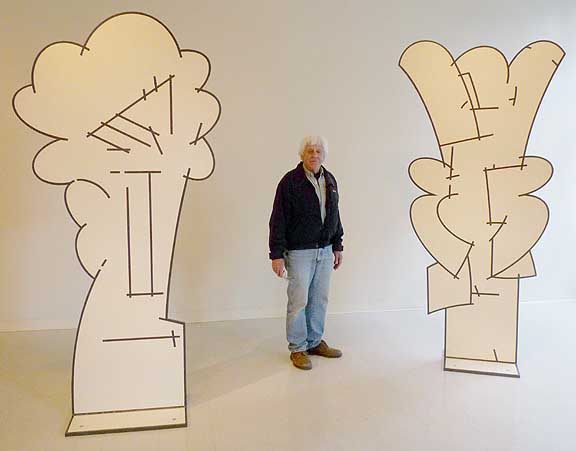 Mel Katz at his March 2009 show Of all of Portland's many longstanding art world figures, none commands the respect of younger generations more than Mel Katz. He's an impressive sculptor who hasn't grown so comfortable with his reputation that he's become stagnant. Though I've watched him for a mere decade, Katz appears to be the opposite… he seems to get more curious and take more risks as the years go by. What's more, no other local artist deserves a serious retrospective than Mel Katz (though one wonders what institution could do it justice?). 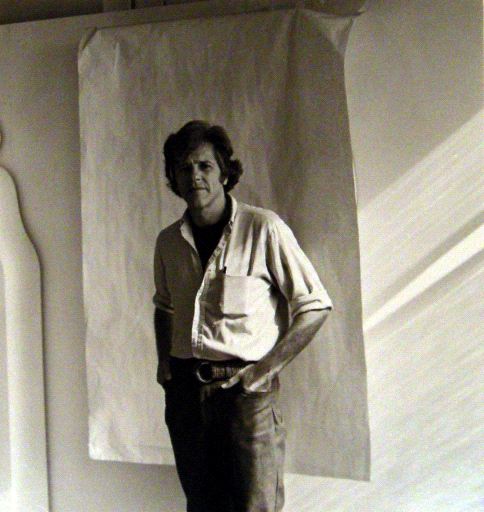 Mary Randlett, Mel Katz, (Summer, 1972) Katz was also a driving institutional force for the PCVA and PSU's art program and during the 70's was somewhat single-handedly responsible for Portland not being isolated from the art world and contributing to the careers of major artists. In fact, the Portland Center for the Visual Arts was ahead of the time doing shows with Bruce Nauman, Richard Serra, Carl Andre, Robert Irwin, Chris Burden and Donald Judd etc. He's the dean of artist driven initiative and intervention in Portland and he has more in common with the constant waves of new artists than CS Price etc… honestly, he's probably the only person in Portland I could identify with when I moved here in 1999 and I admire his gruff candor and insistence on doing something of consequence, immensely. So it was a great pleasure when Katz took time to give PORT a studio tour and talk about New York, the PCVA, the legitimizing force of the NEA, Max Roach and his own work but some budding young historian really needs to spend a year of their life getting a record of what this man has to say about life art and getting into trouble. 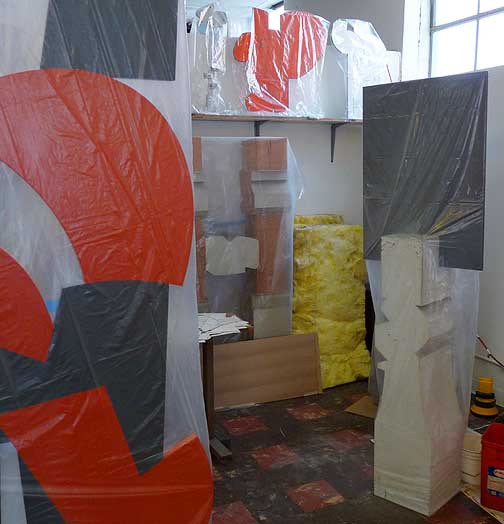 Concrete and steel sculpture (right) Jahn: Should we start with a tour of the studio? Katz: I'll just show you these things then we can talk about them in specifics. For example there are these earlier concrete pieces with steel. The concrete elements almost become pedestals or they can go in the graveyard. J: They remind me a lot of Brancusi who made a the endless column as a memorial but also considered the plinth part of the object, back when it was new for the artist to demand the context in which sculpture was presented, ie existing in a world between life and death. K: They do have Brancusi's sensibility, that's true. (pointing behind a desk full of paper templates) 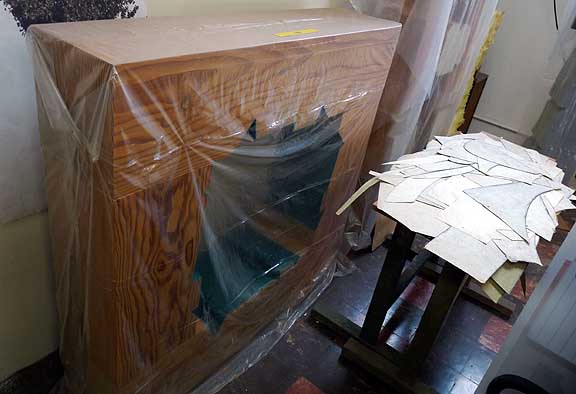
These are some of my earlier wood pieces that have been surfaced. This one in particular was dealing with the interior shape rather than the exterior shape and it lead to the formica works in the 80's. I'm basically surrounded by myself here in the studio. For example, this was one of the earliest pieces where I was moving away from being a painter and using a series of molds then grinding them flat. 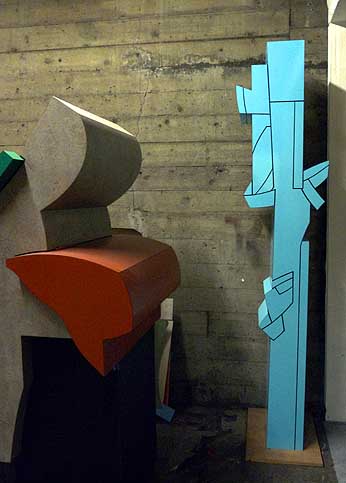
And you can see how the line on these formica things has always been a major involvement. The drawings of course are all about making lines. And the steel pieces are all about revealing lines where a shape relates to a shape… you can see that more specifically here. 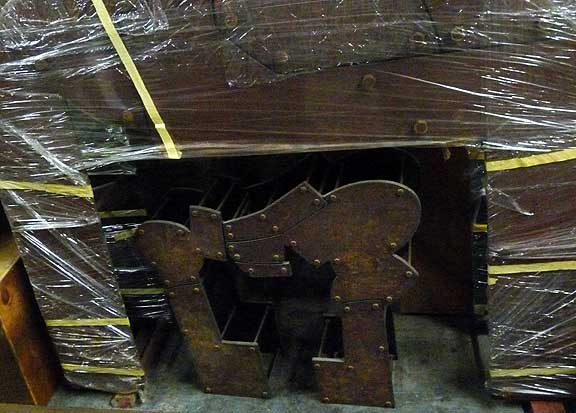
J: And this is made of Corten? K: Mild steel and I was picking stuff that was already rusted out in the yard, when it gets dark it is terrific but most people were not as gracious when dealing with this patina. These formica pieces came after the cast concrete pieces because to make the concrete ones I needed to make molds and the molds were made out of formica. I was looking at the formica molds and thinking gee this is better, this is art. The formica led to these latest pieces, which are seriously non serious. J: It's a mark of a good artist who can insist on having it both ways. There is a younger Portland artist Dan Fagereng who made guitars out of formica and I bet he grew up seeing your formica works. K: Smart guy … and these here are more straight forward steel. They aren't as humorous as the formica works but I'm still playing both sides of humorous and silly with the mass or bulk conveying a certain seriousness that seems a little ridiculous in itself. J: The formica and the latest works remind me graffiti even… but it is true that most of the better artists spend a lot of energy not painting themselves into one corner. 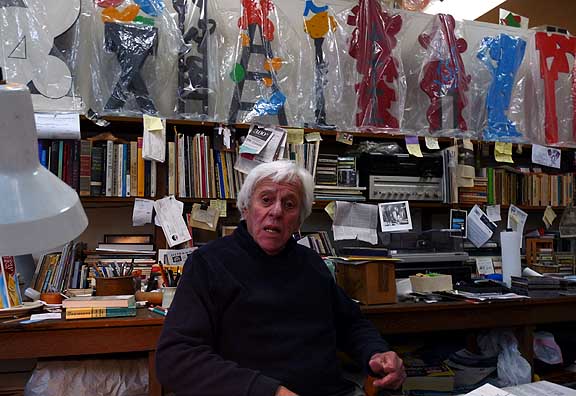
K: What can I say, I think the whole idea is to get into trouble. Once you get into trouble it's about how do you get out? Half the battle is the problem. Right now it's about making a drawing and using technology to make that thing exist. With this program I use, I deal with a programmer that goes to a steel mill that goes to a painter, that goes to the place that masks off. Now there is this whole regimen to, how do you do that? But now I know how to do it and I wish I didn't, because it is very expensive. And now these days nobody wants to spend money in such significant ways when everybody is suffering. J: There is definitely a move away from ostentatious displays of wealth, which is a full 180 from this time last year. K: It's like no no no… I completely understand and I can't do anything about it. You just do your work and as you can see line has always been a concern. Whether it is an overlapped shape or a cut out piece of steel all of them are composed in some drawing manner. Also, all of the drawings, which became these big pieces were life-sized so I'm making drawings that are 8 and 9 feet tall. Then, I don't quite know when I started picking up an 8 and a half inch square paper and making a line… then another line, but then I'd pick out these French curves and recreate that line in a very clear manner, then using whiteout to get rid of the additional illusional lines. I knew how these things would turn out when blown up to a larger scale. When I first started, I didn't know what these things would look like when they got that big so I had to work full scale in the drawings. J: I understand from your background that your father was a tailor so this all seems related. K: That has been in so many articles, I should never say that again! Still, yes my father would make these clothes for myself, my sister and my mother but he also worked in my uncle's shop making stuff. At home he'd have these templates and now I have templates and I remember when I first started doing this I tried to explain to my father that my work and what he did was not that far away. He said, "What are you talking about?" And I said, "Well I use the same kind of tagboard that you use and the depth of some of these pieces is the same as the depth of the cutter in the shop… he'd use layers of cloth that he'd use the cutter to cut through and that was the same depth as my pieces which were up on the wall and I said don't you see it? and he said Noddisheit which means 'foolishness'." I'm a professional, a professor and he's a tailor, and he wouldn't bite. But it is because of him. When people ask me who my artistic fathers are I say, my own father and Arshile Gorky. Those are the two guys that started me. 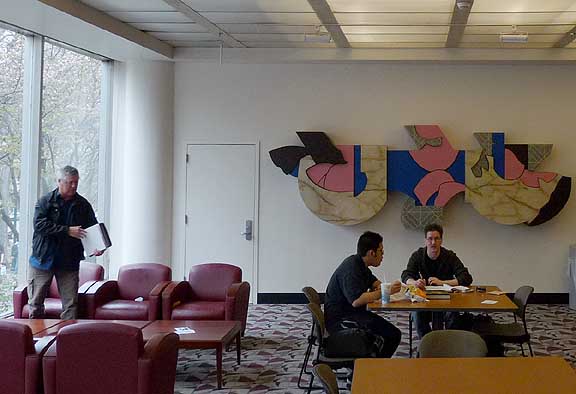 Mel Katz's Troika (1989-90) at PSU's Smith Center J: I was going to ask you questions about if your work is related to clock mechanisms or Moorish architecture like the Alhambra… but that probably wasn't what you were looking at. K: I'm looking at everything, like Calder… he came to me late in life but yet these things I do are so related to Calder. Some things are innate and they come through your inner genes and you don't even know they are there… and if you get to live long you gt to say, "ohhh that is where that comes from?" J: How did you start? 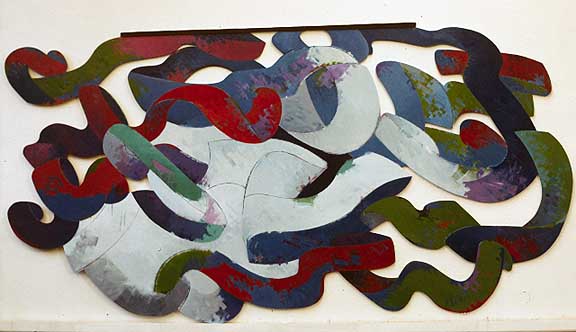
Ribbons II (1966) K: I used to be a painter literally working with Canvas and paint. And then I made a breakthrough with wood panels, cutting out around the corners. There are several paintings where I increasingly cut into the corners until eventually it became this whole shaped thing. It was a painting but it was also an object. J: That was a main discussion for painters in the 60's.. people like Ellsworth Kelly Robert Mangold etc. You also mentioned Gorky, and he greatly influenced De Kooning who used line in much the way you do. He also believed in the ridiculousness of painting… he did the women because he felt the whole pure abstraction thing was ridiculous and it seems like you typically make things that are very refined… but also is the comedian in the room. K: all those guys… I grew up in a time of great creativity, with Franz Klein and de Kooning and yet with Arshile it was his line that got to me. (Mel pulls out his bio) J: That's a good summary, going from nowheresville to becoming an adult. I'm actually going to your old stomping grounds in New York next week. K: You should go see this show… international show of artists under 30, younger than Jesus. It becomes more of an artists space that way… more artists are interested in who's young and hip than the public is. J: What do you think of the New Museum? K: The architecture isn't so terrific, just boxes on top of other boxes…. But then the interior… I don't know, maybe they ran out of money, but then again their whole idea is to not make a Museum of consequence. The architecture says we are all common, this is what we are all about. It fits in with the neighborhood but when you take that view there aren't that many places to sit down in the gallery. J: That's increasingly a trend in museums, particularly ones focused on the contemporary work… For example, MoMA's new acquisitions galleries, it is designed to herd tourists through the space, not create a contemplative experience. It turns art spaces into a series of check lists, did you see this and that. They want you to buy tickets at the beginning then have you move through to see a Barnum-sque Egress at the end. Also, there are so many people you don't get to let the work open up and speak in softer tones. It's more like an amusement park. K: exactly, they want people to get out so more can come in. The key is, are more people going to come back a second time? J: I understand it if it is something like a da Vinci drawings show where soooo many people want to get in, access time has to be restricted to be fair. It's the whole issue of attendance. Museums used to be somewhat empty and contemplative places and now people complain when a museum is empty. K: Well its one of the cheapest venues that you can go to and spend a whole day. If you want to you can be there when they first open and stay for 5, 6, 7 hours and it just costs you the price of admission. Where else can you go for that amount of money. J: That's true, maybe a national forest if you live in Portland or Seattle… most other places don't have easy access to those parks and besides there is a big difference between looking at trees and looking at paintings… you don't engage in the same comparative aesthetics comparing one tree to another… there isn't the same onus on variety that museums often have. So… that brings us to the question of establishment, you've been here a while.  Katz's Red Yellow Blue (1990) behind the Ferrari K: I never thought I would but here I am, an older established artist. J: (laughs) so was there a point you remember when they stopped calling you an emerging artist or a provocative character? K: With me I think everyone was waiting for me to leave… I'm from New York and why am I here? And that was a good question. In fact I know why I'm here, I sublet my apartment in New York and the dude was supposed to be there for 2 years, because that is how long my gig here at PSU was, but he left after the first year… so all of a sudden I've got an empty apartment and now I don't have any money to go back so I tried to get my sister and brother in law to put an ad in the New York Times, but they wouldn't do it… didn't want anybody who was black to come and check out the ad. They were racists, so they put an ad in the Jewish newspaper, nobody came and I lost my apartment. If you lose your apartment in New York, boy are you in trouble... because it was rent controlled and hard to come by. So Vera (former wife and former mayor of Portland) and I had to come up with a new plan, our son at the time was just 4 years old and Vera is saying, "You know Portland is less threatening than New York, this is a better place to have a child." And I'm saying, "You mean you don't want to go back," and she's like, "I don't really want to go back. Then the gallery I'm with in New York closes. So in addition to that my apartment is lost, my wife at that time is saying, "I don't think I want to go back"… sooo what am I supposed to do? At that time I had left the art school where I was as a visiting artist for a couple of years and they couldn't do a third year so I went over to PSU, because Robert Colescott had left… so I took Bob's place there and every time I saw him Id say, it's your fault that I'm here. At that point I started to consider exactly, why I am here? So I got together with Mike Russo and Jay (Backstrand) started the PCVA, which was terrific… one of the most wonderful things that I've ever done. J: When Arcy first started writing for us I told him, you gotta check out the PCVA archives at The Portland Art Museum's Crumpacker Library. After he did I got this excited phone call…, "Jeff, It's the most amazing thing, they had Donald Judd, Richard Serra, Carl Andre and Robert Irwin all in Portland early on in their careers." I have to say this, the PCVA was ground breaking. It was like a prototype for the Dia before the Dia existed. K: Thank you, yes I think it was J: When we put the post up about the PCVA Donald Judd show it got everyone's attention, Chinati, Dia and the Judd foundation because it was a lost show and an important one, arguably the first time Judd used the entire room, essentially making the installation a spatial gestalt and rather than an object it was an environment. It makes sense because his Ottowa retrospective occurred just a month or two later, it was an experimental show with interesting results in response to looking at where he had already been. K: He was a major major international artist and a great writer. J: I understand that Judd didn't see the show until opening night. 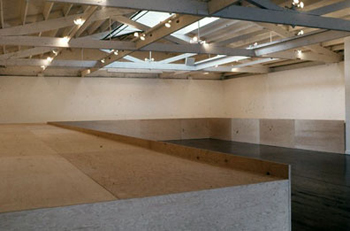
Donald Judd at the PCVA K: He sent instructions and thought he knew what it was going to look like but he gets there he see's it as this wonderful space and found he'd emphasized it's experience. J: I've been up there in the PCVA space, top floor above where Backspace currently is in Chinatown. It has all sorts of horrible cubicles now but it's a perfect space, soaring and vast but not imposing to the visitor. It was a former ballet studio correct? K: Larger than small but not That big J: 5000 sq feet? K: yeah, and we used the spaces on either side of it, we would do installations and performances in the space directly beneath my studio (on the 4th floor) as well so we just spread out across the entire third floor. Then Brian O'Doherty, who went under the art name of Patrick Ireland… he was the head of the visual arts program for the NEA… and we were writing for some funding from the NEA, because if we got some funding from the NEA that would you know, make us legitimate. Well I knew Lionel from New York because his wife was a friend of mine, I went to school with her and I was at his wedding. So many years had passed by and I'm writing this letter and then he gets back to me saying, "I know you." In fact he had written a review of a show I had had in New York. So he comes here after looking at the Kimball in Texas and he looks at the PCVA space that we were gonna be using and he's like, "This is better than the Kimball" and "You gotta write to the museum program of the NEA" and he did a recommendation… literally writes it right there and says, "here take this from me." And we got funding from the NEA's museum program and his program the visual arts program and next thing we know it's a chairman's grant which was like $40,000. At that time $40,000 was a lot of money. So we got a program from that and it was fantastic, People like Judd and Stella and Serra. I was having a great time. And it wasn't only the visual arts, we had these Jazz guys. I got Dexter Gordon to come and play. Guys like Max Roach. J: He's incredible, an amazing drummer… I'm working on it but really Im just a guitarist who wishes he was as graceful and kinesthetic as a drummer. Roach is so out of most people's leagues… I believe great drummers are a massive cultural gift, but they don't get the credit. Great drummers are so rare, its not like other instruments… they set the tone for the entire band and usually own the van everything gets transported in! K: After his concert I asked if I could help him pack up, and he says, "Don't touch my drums!" and Im like "ok" J: So really the PCVA was a way to explore arts patronage on a very high level. You are a fan of great art, as well as someone who has their own studio practice. K: The thing was when I as an artist called Frank Stella, he was talking to me… artist to artist. It's different when it's our gallery director is talking to their gallery director. For example, when I was working out a show with Rosenquist… his dealer, Castelli is in Europe so I can't speak to him. I'm just relating messages, "tell Rosenquist to tell Castelli, when he gets back, to remind him that he wants a show at the PCVA." And that would be a show that takes place in Portland before Castelli can show the same work in New York. …Well eventually Leo (Castelli) comes back from Europe and I keep calling Rosenquist and Rosenquist keeps saying… "I havnt spoken to him yet, I havnt spoken to him yet." Finally Rosenquist gets ahold of him and tells me, Leo doesn't want to do the show in Portland. I say, "You gotta be kidding, we are all set, you are on the calendar, we are ready to make the announcements." So I start calling Castelli at the gallery. I called every day, twice a day for maybe a week until they took pity on me there and I guess Leo did too so they said… "call Leo at the warehouse." So I did and he just read the riot act at me; "Why don't you come to me to begin with, I know Rosenquist, I know what his work is about, I know what works would be best, your place is a barn." And Im try to explain to him that it's not a barn, it's a good place… and after he chastises me I learned a lesson… you just cant deal with the artists by themselves… you have got to go through their dealers and the dealer has to agree. Dealing with de Kooning was the same thing, I didn't go through his dealer Xavier Fourcade and after he reads me the same riot act he turns to me and says, "no way are you going to get a de Kooning show." And we never did. I talked to de Kooning and he said, "I cant fly" and I said we'll get you a special train… we are all waiting for you, you are major here. We didn't have a de Kooning show. J: With insurance values today those exhibitions just don't happen anymore except at major museums and even then, someone like Eva Hesse's work is likely to have had its last major retrospective due to the frail nature of the work. K: Way back, I remember seeing a de Kooning show in new york on 57th street and they were going for $5000 ,which was a lot of money back then. Normally they didn't let kids like me look at that stuff. J: Now they are $5,000,000 or more. In fifteen years they will be 85 million. The good stuff never gets cheaper. In that respect you could say that de Kooning had good dealers. K: The only art that most museums can afford is contemporary art. The old Master's best stuff is already in museums so its incredibly expensive. It's impossible. 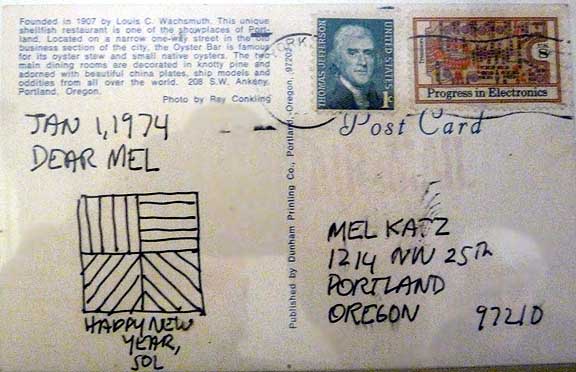
We used to play a game at school and guess which artist today would get a full page, half a page a note or be completely passed over and why? So we would sit around and talk about these artists and it was interesting. Who is going to get that kind of notice. J: Clearly, when choosing artists for the PCVA like Carl Andre, Robert Irwin, Chris Burden, Richard Serra, Bruce Nauman and Donald Judd… you were picking some pretty good horses. K: I had a lot to do with it… yes… but those guys were not where they are now. Frank Stella was still half a step below, so was Richard Serra. Andy Warhol was up there and so was Lichtenstein. I didn't really want to do the Lichtenstin show because I'm not a fan, but if we could do the Lichtenstein show… then do the Lichtenstein. The whole thing was back and forth back and forth… my taste, then not my taste, and to make certain that women were represented, young artists and old artists. And then besides all of that visual arts programming there was Jazz, new music, theater and lectures. Just terrific, it was an oasis. J: It was really really impressive. Last year when we started looking at the archives and doing research on PCVA's Judd show and interviewing Carl Andre it generated a tremendous amount of interest internationally. The Judd show was a lost show and barely understood… now we are working with Peter Ballantine who is probably the worlds leading expert on Judd's production. He's very interested in the group of large scale plywood works the Portland pieces is part of. There was the work at the Lisson gallery, Portland, the incline at dia beacon, and several in Bern which were large scale like the earlier Portland work. Only the Dia one was widely known and Portland's piece was the first time Judd really used the whole room, so its pretty important. It's related to the later big adobe inner wall at the block, Judd's main Marfa live/work compound and the earlier zinc plates that Panza acquired. In scale its closer to the adobe wall and prior to the PCVA Judd had never made such a large installation before. K: Carl Andre isn't too talkative J: it was hilarious, every answer was just a sentence or two, and he gave his answers in red text K: Well he's into concrete poetry J: That's why we published it in the form Andre sent us, with red text. K: That's what I would do J: But the thing is Portland hasn't taken credit for what it has accomplished over the years, especially culturally and the PCVA was major… the Dia before the Dia existed. K: It's true, it really doesn't take score… what's with that? J: I don't know, buts it's changed a lot lately in that regard… maybe we should name the new transit/pedestrian bridge after Rothko? Maybe the PCVA deserves a more public celebration on the transit mall that is being put in right in front of it? K: Back then for the PCVA artists if Portlanders didn't see something in print or if they weren't showing at The Modern, then they didn't know who they were. For example we wanted to bring Twyla Tharp here to Portland. And this one fellow responsible for booking some of the better halls said, "Who is gonna come?" And I said, "this is one of the most important modern choreographers of our age, of course people are gonna come." But he said no and I had to call her back and say, "we cant do you." And she says, "Oh ok." J: See things have changed, White Bird brought her out in 2003 K: Because of the PCVA PSU started its dance program and eventually The Portland Art Museum picked it up because it lost its NEA funding. Eventually that Art on The Edge program's director Kristi Edmunds started PICA. When she and John Weber left that's also when White Bird started. J: A lot of people don't know the chronology of it, they somehow think that Kristy Edmunds started PICA without any preceeding posts and activity and grew PICA full formed from the head of Zeus. Then they think that people with no background or eye for art are to be taken seriously as leaders of non profits. But that cultural amnesia hurts our perspective on creating new institutions, with faldse starts doomed from the get go. One has to have connections… you had connections. Today you have to know what you are doing, it takes more than a space and an open invitation for anyone to show. K: Well if nobody does something on the PCVA soon all of us are not going to be alive. J: It is why weve started to dig around, when we put them up there was a lot of international attention. The Judd Foundation, etc. Still, I think this is a great thesis project for some art history grad student. It deserves the attention, weve already done Judd and Andre, we've interacted with Irwin a bit over his recent retrospective. K: Well I know Bob pretty well and he did a wonderful piece for the PCVA. Once I was standing on a Noguchi the size of this whole studio at Storm King. Suddenly someone taps me on the shoulder and says, "do you need a guide?" and it's Bob. J: Great story, Robert Irwin is about the most intelligent creature I've ever encountered. Also, I love the name of that place "Storm King." K: It's a wonderful place, you can look at sculpture from a hundred feet away so it looks tiny in the vastness of space. And Bob is exceptional. I invited him to do a talk at PSU once. So I pick him up at the airport and he says, "Ill just talk, you just bring people in and Ill talk." So somewhere around 10:00 my class is there, then the class was over and another class comes in and he kept talking. Somewhere around 3:30 or 4:00 comes around and I come in and he says, "in about 10 minutes all be done." So we go out and gets some cokes and sit on a park bench in front of the school and we talked some more and from that time on we've been pretty good friends. 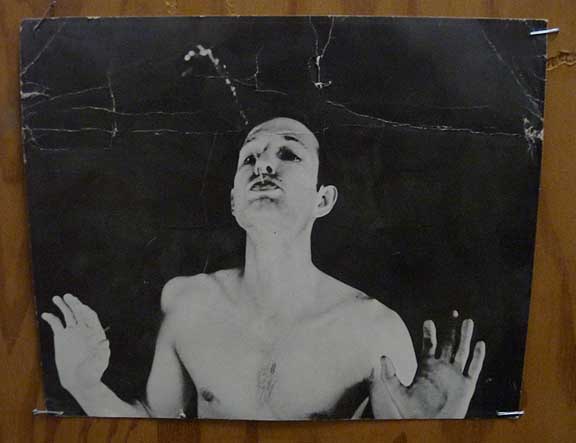
And Bruce Nauman did a terrific show at the PCVA too. Let me show you this, "The Artists as a Fountain"… that was it. J: And people were probably a bit perplexed K: And would be today too J: Well that's Nauman's whole thing, he wants people to take an investigative attitude. K: He did a piece at the PCVA that was a long pathway that was open at one end with two spaces off too the side and a radio on the other end that was off of a station. The pathway was just wide enough to navigate shoulder to shoulder and you could see these spaces on either side but you had no idea if there was anybody in those spaces. And you could hear the sound but you couldn't really make it out. Then as you go closer and closer to those spaces there would an increasing sense of unsureness. And invariably there would be someone there… some other art enthusiast. And then you got closer to the radio and it was obviously off its station so you'd try to make your way out and hopefully nobody was going to come in. J: One of the single biggest tragedies was the local community did not collect from the PCVA shows… those pieces are now stars in MOCA and the Guggenheim collections (via Panza) K: That's why we started this Artists Intitaitive for a Contemporary Arts Collection. After the PCVA we thought we could work with our patrons, get artists to lend us work for 5 years and we'd buy the work, building a world class collection. Stella, Andre, Le Witt etc. but the patrons were 25 years older than us and were more interested in their grandchildren. We figured if someone gave us enough money it would be named after them, a terrific idea. 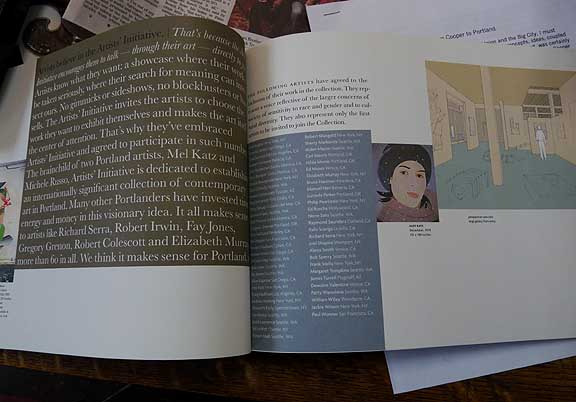
brochure for Artist's Initiative for a Contemporary Arts Collection J: Yeah and it would have been the time to do it then too (1980's) K: Ellsworth Kelly though it was great and was all for it but he said he felt his work looks best when it is surrounded by itself. So I tell him… look when we open our space Id like you to be the first artist to show work. You would select the work, come to Portland, install the work and meet everybody that really likes what you do. He said fine… but it never happened. J: And he keeps getting better K: That's what you are supposed to do, I think I'm getting better too J: I thought this last show was the best Ive seen from you in the past decade. The relationship of line to drawing is changed. Its no longer direct but I feel the phantom limb of the original pencil marks even though its 9 feet tall and mechanically produced. They are finished works that recursively reference their origins. In a way the work is becoming more schematic. They are flat though they have volume… and I know you are not very into Roy Lichtenstein but they remind me of his wry, dry and flattened sense of humor. K: Well I can see your association with it, when you get to the side of mine it is just a line. Its about being serious in a non-serious way. For example, I saw these cascading circular forms and immediately it reminded me of Shirley Temple, so that was the title. When I find something as quickly as that I don't reconsider, that's it… that is what it is called. Other names came into focus in similar ways like Ben and Jerry's. When you find one it pushes thoughts of other kinds of similar names and they become part of a grouping. I think the difference for me with these smaller drawings is they come to me so quickly. Some work and some don't and I like this white out, it's so crusty. These works are so humorous because at times you might see features and it becomes almost figurative as compared to something like this, which is less humorous. J: It seems more mechanical, whereas any time there are more cuvres it implies more organic forms like the trunk of an elephant or an easy chair. K: I never saw an Eames chair there till now. J: Telling that you turned my easy chair reference to an Eames K: (laughs) Posted by Jeff Jahn on August 28, 2009 at 16:37 | Comments (3) Comments Mel just keeps getting better and better. His last show was phenomenal. It's great hearing about some of the inner working of the PCVA. It's a shame we don't have a comparable space these days. Posted by: Calvin Ross Carl Thanks for this interview. And thanks to Mel for his work and his contribution to the city. That Robert Irwin visit to his class at PSU changed everything for me. Posted by: robertjohnson It is interesting how frequently Irwin seems to change people's lives. Meeting him and interacting with him for an afternoon was a complete highlight for me. As for having an institution like the PCVA... one just couldn't do it that way now. Thing's have professionalized to an increasing degree and it's why the PAC experiment kept zigging when it needed to zag (it was right by the PCVA even). Sorry, but they don't really deserve mention in the same paragraph. PICA's program until Jamuary 2004 does deserve to be mentioned as a followup to the PCVA. The thing comes down to the NEA seed money and people with savvy and connections. I sense the Lumber Room will open soon and that residency situation will fill some gaps that PICA's departure from the year round vis-art scene left. The Lumber Room has a wonderful space but it isn't quite as awesome as PCVA's... That said it's much better than LAX art's. On a grander scale maybe a public/private partnership could get it done in the near future here (private donors alone don't seem to have the initiative)... it's obvious Adams will have to think boldly if he wants to get re-elected. MP5 clearly isn't a feather in his cap though... at least it isn't public money. A lot of lessons learned there though. For an art center to work it has to be close in. Also, if anyone is to consider any kind of major art center (budget over 1M, which is what it takes now to be relevant on an international level) they should talk to Mel Katz quite a bit... or at a minimum read this interview and understand how the game changed. Posted by: Double J Post a comment Thanks for signing in, . Now you can comment. (sign out)
(If you haven't left a comment here before, you may need to be approved by
the site owner before your comment will appear. Until then, it won't appear
on the entry. Thanks for waiting.)
|
| s p o n s o r s |
 |
 |
 |
 |
 |
 |
 |
 |
 |
 |
 |
 |
 |
 |
 |
 |

|
Site Design: Jennifer Armbrust | • | Site Development: Philippe Blanc & Katherine Bovee | |


![[TypeKey Profile Page]](http://www.portlandart.net/nav-commenters.gif)